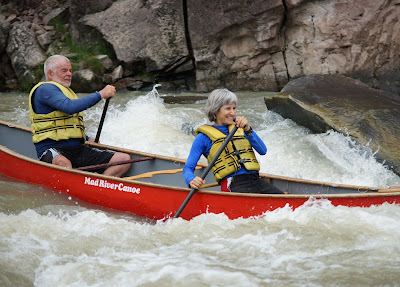Goosenecks of the San Juan River
On our way to Cedar Mesa in southern Utah in April, Mike Scudday and I made a brief stop at Goosenecks State Park. We arrived there early in the evening. The panoramic photo above shows the major portion of the twists and turns of the San Juan River which can be viewed from the park. If you click on the photo, you should get a better look at the amazing scenery. On the horizon in the center of the photo, you can barely spot a few Monument Valley rock formations.
Looking down to the river, we could see that a party with what appeared to be three rafts and an inflatable kayak had pulled over on a sandy bank to pitch their tents and set up camp for the night. You can spot them at the edge of the sunlight on the river.
Near the horizon, and to the left of center, is Alhambra Rock. This volcanic feature is about four miles to the south of the park, and about 2.4 miles to the southwest of Mexican Hat, Utah.

















































